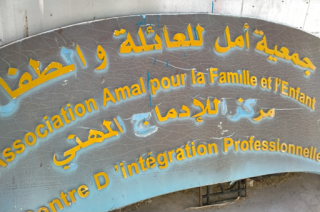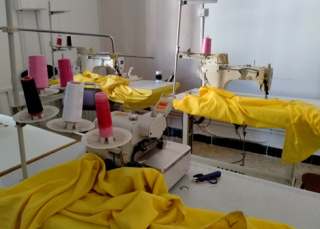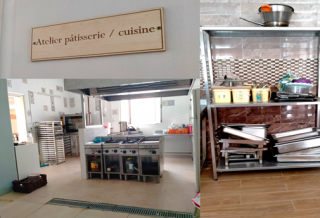Hamida Jridi
MA student at University of Tunis El Manar,
Researcher at the Center of Arab Women for Training and Research, CAWTAR
Introduction
The Tunisian youth and women in particular have struggled in the past in terms of socio-economic conditions before the pandemic; many women suffering from domestic violence were also suffering from poverty, lack of financial autonomy and unemployment. Several studies and surveys reported (CREDIF, 2018)[1] , (Coulibaly, 2019) that the lack of autonomy is an aggravating factor contributing to violence against women. Statistics in the Arab countries and specifically in Tunisia indicate that women are the most affected by unemployment (Global Gender Gap Report, 2020).
The three-year research project where I’m involved as a Tunisian researcher has three steps. The first phase of data collection included 11 visits to different institutions such as training and safety shelters for women during summer 2020. During the visits I conducted 15 semi-structured interviews with the staff working in the different centers. The next step, during the year 2021, is to collect quantitative data about the institutions through a survey which will allow us to develop an accurate mapping of the support services on one hand and to analyze the challenges caused by the lockdown[2]. The third step, taking place in 2022, is to conduct focus-group sessions to gather information from the various stakeholders involved in the economic integration programs, in order to elaborate recommendations as based on the exchange between the different actors and an analysis of the repercussions of the pandemic on the women affected by the crisis and the measures to overcome them.
In this blog, the work is focused on one of the nine organizations visited during the summer of 2020, namely the Bardo training center as well as the students and the curriculum it provides for them. The “Center for Professional Integration” is under the supervision of the Amal (Hope) Association for the families and children (Association Amal pour la famille et l’enfant). It provides for the study a site for a case study and a starting point to look into the complex transition of these populations to be employed and independent. The center for social/professional insertion is located in Bardo, it’s one of the Amal association projects. It has been open and running the training cycles for 6 years. Having had 10 classes in one of the training sessions and 9 generations in two other specialties, the center is considered a reference in this type of missions.

Photo 1: The old banner of the center will be replaced since they have a new location. It reads the name of the association and the center in Arabic and French. (Hamida Jridi)
The director has worked in the center for 3 years, after working for 16 years in the shelter. She calls the population they are concerned with , as “vulnerable women” referring to both social and material vulnerability which can include violence from their partners or families and single mothers.
The priorities according to the director are the following:
The women who are poorest, most vulnerable, dealing with more obstacles, they are most prioritized. The institutions sending them have to provide us with a “dossier” [3]with all the details. However we conduct our own interviews and in some cases we visit the women’s homes or environments. In most cases, if they are coming from an “integration center” [4]or an association shelter: that is indicative of their really bad situation. Usually when they are home, for example with their families, it’s usually better even if they are poor. Those who come from the shelters are the priority. We do the interviews and in case someone doesn’t show up, we call those who are shortlisted to replace them.
The center accepts also boys, and their share has been recently around 10 percent. The director reasons this as follows:
As for the boys, we go through the same process and we have done it since we started but we never allow for more than three guys because the center was mainly made for women when the project was conceptualized, it was for women. The other youth integration centers [5]have boys, and instead of being lost, we provide them with the possibility to learn a skill.
The women who are living in shelters usually prioritize finding a job on getting vocational training. Not all of them have the time to take classes and then look for opportunities and trying a few jobs. For them the aim is to be employed as soon as they can so they can leave the center. This is for them a means to become independent which is of utmost importance and in some cases it is actually their ticket out of the shelters. In this sense, they would not follow the same path as the students. Thus, minors living in the association’s shelter are usually what make up most of the trainees since they will be spending a longer period of time in the shelter anyway and do not have the right to work otherwise.
The training center offers up to two training cycles each year depending on the demands of the students and partners. All the courses last 6 months each but the time for traineeships vary. It can take up to 7 months in some cases and they offer three tracks/specialties for the students to choose from as soon as they join the center: 1) Caregiving courses, 2) Pastry / cooking courses, and 3) Tailoring /sewing courses.

Photo 2: The sewing work space in the center (Hamida Jridi)

Photo 3: The kitchen for the cooking and pastry classes (Hamida Jridi)
Training centers foster occupational gender segregation through the curriculum
Long before facing wage gap challenges or workplace discrimination and harassment, the trainees of these centers are already set up for some challenges in their professional path. The very first issue being the limitations they have when choosing a specialty for their diploma. The options provided in the center we study are not different from any of the other support centers providing vocational training. In fact, the addition might be a specialty in beauty (hairdressing, styling…) which is another option based on traditional social and cultural images of women. These stereotyped images of women’s roles limit their potential to explore other talents, skills and excel in them according to their own interests. Thus, decreasing their employability and the job opportunities they can all compete for in the radius of the training center they are graduating from on a local level and the job opportunities in their region or country as a whole. The decrease is problematic because these training centers are also competing with other private training centers which usually have more resources to fund different courses and to update their curricula regularly which make their graduates more sought after.
Meanwhile, the graduates of the Bardo center, are in dire needs for jobs and sustainable living income. Yet, their training will only allow them to compete in one field with skills that can be outdated in some areas. These women often times find themselves leaving their homes and families because they no longer feel safe. When they move to a new environment, they realize they have to start earning a living and being independent in order to start their lives over. This means, they are redefining themselves and the terms by which they live their lives in many aspects. However they find that they can choose to do one out of three paths that only reinforce the society’s idea of who they should be, what they should do and how they should do it. They have to make a decision to either be a caregiver to elderly or sick people which some of them could have at her home too (caring for their children as single parents, or looking after parents/family members). So, the option to reinforce the importance of her caregiving role and sometimes her motherhood is sometimes the only option for her to be financially independent and refusing to be limited to that role specifically in her own life, and having to do so in many communities is itself a way to challenge social norms and the narratives many women have grown listening to and learning from.
The second and third options are examples of jobs and tasks illustrating the stereotypes on women’s roles and missions. Cooking, baking, sewing and tailoring also belong to the tasks women perform according to certain worldviews. This also reinforces the gender stereotyping function of these training paths and the challenges they would present to the candidates trying to choose a path for themselves to be independent.
Material and technical deficiencies translate into sustainability challenges
Although entrepreneurship is an advantage in some cases where the center’s partners can secure extra funds to kick a start for the graduates’ own businesses, it remains another limiting factor that the majority of training options take the beneficiaries to the path of entrepreneurship. Entrepreneurship, business or project management, fundraising are all crucial for these women to start working on their own after graduating. However, these are not the subjects they are taught at the training center. In fact, they get the full on experience of learning the specialty, the skills needed for it and they practice it during their traineeships during or after the sessions but they do not receive any resources to learn from or even regular events or meet ups with professionals (similar to the classes taught by the lawyer, the psychologist and the midwife).
The graduates of the training center do not always follow the path they have chosen when they started these classes. Many of them even drop out before the end of the course because they are not fulfilled when doing this job. Besides the limiting stereotypes that they have to fit in, the possibilities of finding jobs easily is decreasing since most of them (especially coming from the shelter) choose to move closer to its location because it provides a kindergarten for their children – which is a necessity if they want to be employed and earn a living with a fulltime job. Hence, starting their own businesses is the alternative but it is problematic for many reasons. It is problematic for the graduates on one hand, and on another hand it is problematic for the institution itself since this can hinder its progress and sustainability.
The issue with the aforementioned diplomas is that they allow for graduates to start business when they have the means to do so. However the graduates in most cases are in precarious situations. Usually they have little to no income, and many crucial expenses such as: legal expenses, medical care expenses as well as family responsibilities. They are in challenging social and financial situation. This is because of the hard psychological state they usually live through when recovering from trauma, but also because taking a risk of raising enough funds to start an entrepreneurial endeavor does not appeal to them or does not seem possible. It is not something that most of them consider, especially because their training programs do not expose them to the idea or the skills needed for this type of projects nor do they find guidance from professionals who have had the experience and expertise in a certain field.
The deficiencies of the system are manifested in many aspects. Deficiencies in the skills that the staff can provide are one of the main reasons for the worry about the future and sustainability of such support services. This center does not have or has very limited access to skilled professionals with knowledge of the entrepreneurial ecosystem, of the digital communication tools, or the mechanisms to provide funds and micro-credit loans.
The teachers of the center have been the same team for the past few years. Only one teacher was replaced and the curriculum has not changed since it was taught the first time. The teachers themselves are not equipped with skills to update their teaching materials or to evolve and develop their teaching styles as they are busy performing the same work load once or twice a year in order to maintain the activities of the center.
The centers are also lacking financial support to buy the needed materials for better learning experiences that the students can benefit from. The tracks made available in this center require technical skills, and the practice during the traineeships only lasts four weeks which might not be sufficient for any student considering launching their own businesses. Not exposing the students to the right opportunities or even connecting them to the external network needed to launch an entrepreneurial project is also difficult because of the limited financial resources managed by the center and the association.
The overlooked need for support: when the centers themselves are lacking resources
This study is an ambitious attempt to understand the underlying issues that the training centers face in an ecosystem that is already hard for some women to get access to. Although the priority and the reason of being for these centers is to empower women and equip them with all the right technical and financial tools to be independent, they seem to represent another hurdle to some of them.
Since the lack of financial support is omnipresent for the staff of these entities, their main mission has been to maintain what they already have. At the moment there is not enough critical thinking as to what the center’s needs are. The staff has been responding to what they consider urgent matters or typical tasks such as starting a training cycle every year or finding a job to a woman at a high safety risk. Even the need to evaluate the underlying effects of the curriculum they provide has been overlooked. All of this reduces the possibilities to develop the project or its sustainability in a worsening economy and increasing rates of violence.
Analyzing the way the centers function and how they tend to the needs of their students not only allows to understand their obstacles but it also clears up many of the issues that the vulnerable women face when transitioning from one stage of their life to another. However, this analysis can only follow after the thorough exploration of this area and the different modalities of training in these support services.
References
Coulibaly, Seydou. « L’autonomisation économique des femmes victimes de violence conjugale : points de vue d’intervenantes en violence conjugale et en employabilité ». Université Laval, 2019.
CREDIF, et UNFPA. Les représentations sociales des violences faites aux femmes chez les hommes, jeunes et adultes. Tunis: Crédif, 2018. https://tunisia.unfpa.org/sites/default/files/pub-pdf/Etude_CREDIF_20_02_2019.pdf.
DÉSILETS, LAURA, MYLENE FERNET, MAGALI VIDEAU, HADEEL QAZZAZ, ROXANA GALANT, ZAINEB AL-HINDAWI, NOUR ALI, et MICHAËL ARNAUD. « Explorer les effets des initiatives d’autonomisation économique des femmes sur la violence domestique ». OXFAM, septembre 2019.
Nations, United. « L’ONU met en garde contre la persistance des violences domestiques après la COVID-19 | Nations Unies ». United Nations. United Nations. Consulté le 5 avril 2021. https://www.un.org/fr/coronavirus/articles/persistence-of-domestic-violence-post-COVID-19.
UN Women. « COVID-19 and Ending Violence Against Women and Girls ». UN Women, s. d. https://www.unwomen.org/-/media/headquarters/attachments/sections/library/publications/2020/issue-brief-covid-19-and-ending-violence-against-women-and-girls-en.pdf?la=en&vs=5006.
[1] https://tunisia.unfpa.org/sites/default/files/pub-pdf/Etude_CREDIF_20_02_2019.pdf
[2] https://edubirdie.com/wp-content/uploads/2023/06/policy-brief-the-impact-of-covid-on-women.pdf
[3] A file : a complete folder with the information about the person, concerning the case and their history.
[4] « Centre de Défense et d’Intégration Sociale (CDIS) » up to 16 in the country as well as the « Centre d’Encadrement et d’Orientation Sociale” under the authority of the Ministry of Social affairs.Both are institutions that help youths (minors) facing dangers of abandonment, deliquency and little to no material and moral support. They provide shelter, medical and psychological support and opportunities for stability, regular education or vocational training.
[5] Specifically the Centre de Défense et d’Intégration Sociale of Ezzahrouni, the closest center to the facility ; they are usually the ones who send trainees to the Amel Association.
